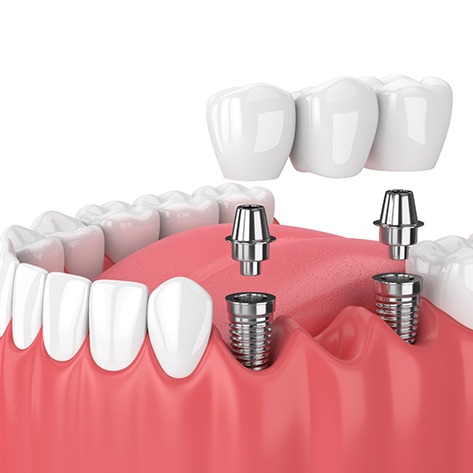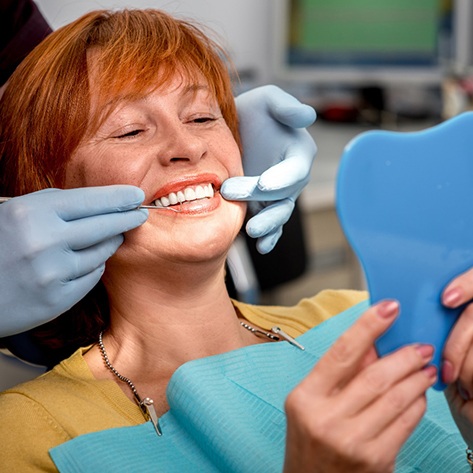Dental Bridges – West Loop Chicago
Bridge the Gap in Your Smile
Nobody likes having a gap in their smile, but fortunately, modern dentistry offers great solutions! If you're missing one or more consecutive teeth and the ones on either side of the gap are healthy, you may want to consider getting a dental bridge. At Washington Dental Care West Loop, Dr. Hammes is an expert at filling in that space, ensuring your smile looks and feels complete again! Not only will this greatly boost your appearance, but it will also prevent other teeth from shifting and reduce the risk of gum problems. To find out if a dental bridge in West Loop Chicago is right for you, continue reading or give us a call today.
What Is a Dental Bridge?

Dental bridges are designed for patients with one or more missing teeth in a row. Unlike partial dentures, this method of tooth replacement uses dental crowns or implants to securely anchor the artificial teeth (pontics). Since the materials are available in several lifelike shades, these prosthetics can seamlessly fill the gap in your smile. Not only do they look natural, but they are also highly durable, ensuring your bite remains strong and unaffected!
Types of Dental Bridges

First things first, you need to schedule an initial consultation with Dr. Hammes. During this session, he will perform a thorough oral examination, discuss your goals, and review your medical background. Following his assessment, Dr. Hammes will suggest an appropriate treatment plan from the following options:
Traditional Dental Bridges
A traditional dental bridge can replace either a single missing tooth or several. This restorative treatment requires you to have a natural and stable adjacent tooth both in front of and behind the space intended for restoration. We essentially restore your smile by "bridging the gap" with a single structure comprising three or more teeth.
Implant Bridges
An implant bridge uses dental implants instead of crowns. These titanium posts are strategically positioned on either side of the gap in your smile. Once they have successfully fused with the jawbone, we can attach a dental bridge to the implants, effectively replacing two or more missing teeth. Known as the most durable method of tooth replacement, an implant bridge requires surgery to embed the implants into the jawbone.
The Benefits of Getting a Dental Bridge

By opting for a dental bridge in West Loop Chicago to replace your missing teeth, you can look forward to numerous benefits, such as:
- Maintained alignment of your current teeth
- Improved oral health
- Easier cleaning and maintenance
- Preservation of jawbone with implant bridges
- Long-lasting results (15 years with traditional bridges and 35+ with implant bridges)
- Achieving a naturally appealing smile
Dental Bridge FAQs

Can You Take a Dental Bridge Out?
No, you should never take a dental bridge out on your own! Dental bridges are specifically designed to be a permanent solution and are intended to remain in your mouth for many years after being placed. It’s not recommended to attempt to remove a bridge without professional assistance. Only a dental professional has the expertise and tools necessary to safely and appropriately handle the removal of a dental bridge. It’s worth noting that while some healthcare providers may refer to partial dentures as "removable bridges," there is a notable difference. Partial dentures, unlike bridges, can be taken out by the patient at any time.
Is Getting a Dental Bridge Painful?
Don’t worry – getting a dental bridge is generally painless. Most dentists use numbing agents during the preparation process. A topical anesthetic is typically enough for most patients, though sedation is an option for those with severe anxiety. After getting your dental bridge, it’s normal to experience some sensitivity in the underlying teeth for a few days. The good news is that you can alleviate it with over-the-counter pain medications.
Keep in mind that dental bridges help prevent discomfort from dental drift by maintaining tooth alignment. For those choosing an implant bridge, soreness after implant placement is expected, but dentists provide aftercare instructions to minimize post-surgical pain and ensure a smoother recovery.
Do Dental Bridges Look Natural?
Yes, dental bridges can look very natural, especially those made from metal-free materials such as ceramic and zirconia. These materials are carefully color-matched to your existing teeth, providing a seamless match with the surrounding enamel. The ceramic and zirconia components mimic the appearance of natural tooth enamel, even in the way they reflect light.
Once the bridge is in place, it should seamlessly integrate with the rest of your smile. It's important to note that bridges made from visible metals like gold or silver may not appear as natural, but they are typically reserved for non-visible teeth.
Can Dental Bridges Get Cavities?
No, dental bridges themselves cannot develop cavities. However, the natural teeth underneath the bridge are still vulnerable to decay. Food debris can accumulate beneath the pontics or in the space where the crowns meet the gums, attracting harmful bacteria and potentially causing cavities or gum infections. Poor oral hygiene increases the chances of these issues, emphasizing the importance of daily cleaning under and around the bridge. Additionally, as a bridge nears the end of its lifespan, the cement securing it may develop cracks, providing openings for bacteria. This could lead to infections or decay in the underlying teeth.



